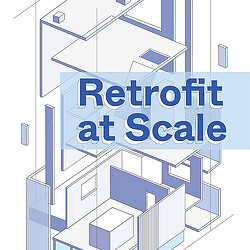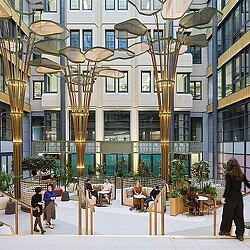Retrofit at Scale: A New Blueprint for Investible Urban Development
A conversation with Gensler’s Harry Cliffe-Roberts and Opportunity London’s Jace Tyrrell on why retrofit is emerging as a preferred solution — and how this cross-industry guide is helping move the dial.

Across London and beyond, the need to decarbonise the built environment has never been more urgent. Yet despite widespread agreement on the importance of reuse, retrofit still faces fundamental barriers — from policy inertia to financing gaps and a cultural lethargy to embrace change.
That’s why Gensler and Opportunity London brought together a cross-disciplinary working group to ask the hard questions: What’s holding retrofit back? And how do we move from ambition to action? The result is the Retrofit at Scale Guide, setting out five key pillars for unlocking retrofit as a mainstream, investible solution.
Here, we speak with Harry Cliffe-Roberts, Building Transformation & Adaptive Reuse leader at Gensler, and Jace Tyrrell, CEO at Opportunity London, on the guide’s creation, the ideas that shaped it, and the ongoing work.
Harry Cliffe-Roberts: London’s building stock is outdated and increasingly unfit for purpose, outpaced by changing needs and rapidly evolving requirements. New is not necessarily better, and we need to push beyond older throw-away mindsets to maximise what we already have. It’s clear that the industry needs to create alignment — around why retrofit matters, how it can be achieved, and who the key stakeholders are. Given all these factors, why is this guide urgent and necessary right now?
Jace Tyrrell: The need for retrofit isn’t new, but we’ve reached a tipping point where market dynamics, policy, and public opinion are converging. We needed something that cuts through complexity and makes retrofit not just technically viable, but also commercially and culturally attractive. This guide creates a common language and a scalable playbook so investors, owners, and boroughs can align quickly and turn intent into investable pipelines.
Harry: During this process, I was struck by how aligned people were and the appetite for clarity across the whole working group, regardless of their discipline. It was immediately clear how disconnected the systems still are within which we operate — we had leading voices from across the industry in the same room, all saying “we want to do this,” but all hitting various barriers. What did you learn from the working group sessions that changed your perspective?
Jace: There is a real appetite for clarity and practical tools. The five pillars came directly from that: real levers we can pull if we want to scale this. For investors, the standout was the consensus around shared definitions, an open dataset for retrofit, and one trusted energy-performance baseline. That makes decisions faster and more consistent and turns retrofit into something lenders and buyers can back repeatedly, tied to a clear pipeline of London projects.
Harry: Risk comes from uncertainty, but smart design and strategy can mitigate it. Whether it’s better data, clearer performance benchmarks, or shared success stories, we need to normalise retrofit to de-risk it. This means investing in specific education, developing skillsets, challenging information voids, and evolving industry frameworks. What would you say to someone who sees retrofit as too risky?
Jace: Retrofit strategies can reduce planning and delivery risk versus rebuilding; you work with the existing structure and phase works to preserve income and get to market faster. Our guide pulls together mainstream tools — green leases, measurable performance targets, insurance-backed guarantees, and performance-linked finance — so outcomes are priced, not guessed. In short, we convert uncertainty into priced risk and bankable cash flows.
Harry: The primary objective is to get the guide into more hands — developers, lenders, planners, designers, and so on. We all have our part to play, and we need to establish shared alignments that will start to shift the systems. The guide is scalable as a framework, and we also need to localise it. We’re already having conversations about how the identified pillars and opportunities play out in other cities. The challenges vary in acuteness, but the principles still apply. Now that the guide is out in the world, what’s the next step?
Jace: As investors keep telling me, markets reward confidence and comparability. The next step is to turn this guide into investable, de-risked deal flow. Our ambition is to launch a Retrofit-First London map with an open-data backbone that shows where the most bankable opportunities are by asset type, age, energy intensity, and adaptability. Standardised definitions and metrics will let capital compare like-for-like, cutting diligence time and unlocking scale.
Harry: Designers can help shift perception by reframing retrofit not as a constraint, but as a brief for creativity. When delivered by designers who understand the intricacies and nuances of working with existing buildings, retrofits offer an opportunity to deliver unique, compelling, and more sustainable buildings. What role do you think design can play in this transition?
Jace: Design plays a major role, not just in solving technical challenges, but in shaping how people feel about retrofit. If we can make it aspirational and show the value clearly, investors will see it as a core product. Designers are uniquely positioned to turn ambition into something tangible.
Harry: If the process of writing Retrofit at Scale taught us anything, it’s that the potential is there, but it is fragmented. Alignment will be the catalyst to unlocking it, eventually leading to real, fundamental change. If you had one retrofit “wish” for the year ahead, what would it be?
Jace: My wish is for investors to see high-performing retrofits as mainstream, not niche. If we agree on one trusted performance standard and make data open, processes get faster, and financing gets cheaper. That makes retrofit a reliable way to protect income, keep assets attractive to tenants and buyers, and put more capital to work in London.
To download the Retrofit at Scale Guide, click here.

For media inquiries, email .









